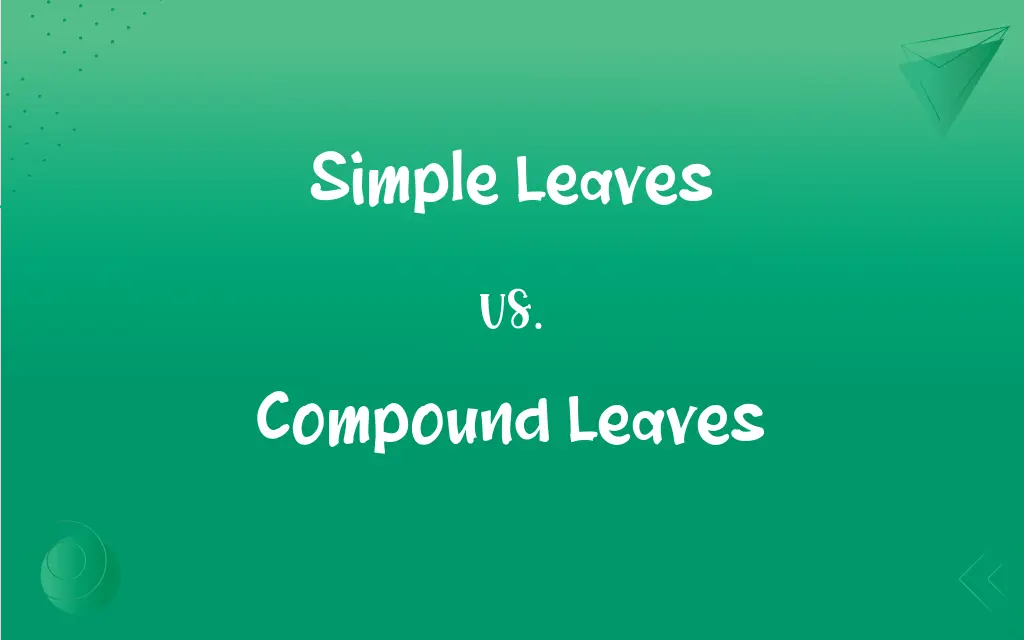Simple Leaves vs. Compound Leaves: What's the Difference?
Edited by Aimie Carlson || By Harlon Moss || Updated on October 7, 2023
Simple leaves have a single, undivided blade, while compound leaves have a blade divided into leaflets, often arranged along a central stalk.

Key Differences
Simple leaves are characterized by a single, unbroken leaf blade that extends directly from the stem. This structure gives the simple leaves a straightforward appearance, where a single leaf emerges per node, visually providing a neat and unblemished surface. On the other hand, compound leaves present a more intricate structure, which involves multiple leaflets emanating from a single stalk or petiole, often giving them a visually complex appearance.
In botany, the understanding of simple leaves is foundational as they represent the most basic form of leaf, with each leaf being undivided and often exhibiting various shapes like oval, round, or lanceolate. Compound leaves, however, depict a more elaborate design, often captivating botanists and gardeners alike with their array of leaflets, which might resemble a mini-forest on a single stalk, providing a unique aesthetic and structural functionality to the plant.
When observing simple leaves, their functionality and aesthetics may seem straightforward, providing basic photosynthesis and transpiration mechanisms for the plant. In contrast, compound leaves bring forth additional intrigue in their biological functionality, potentially offering the plant adaptability to varying light conditions and protective mechanisms against predation, as the complexity of their structure might deter herbivores to some extent.
Simple leaves exhibit their own plethora of shapes, sizes, and textures, offering a rich diversity in the plant kingdom with their own unique contributions to the ecosystem. While compound leaves, with their compounded leaflets and complex structures, not only contribute significantly to the ecosystem but also add a distinct visual depth to the environment, serving both functional and aesthetic purposes.
Regarding simplicity and complexity, simple leaves serve as an emblem of straightforward functionality in the flora world, underscoring the capacity of singular, unpartitioned structures to facilitate vital life processes like photosynthesis. Compound leaves, with their divided leaflets and occasionally intricate layouts, embody a detailed and sometimes delicate expression of nature’s capacity for structural and functional diversity, thereby enhancing our understanding of botanical complexity.
ADVERTISEMENT
Comparison Chart
Basic Structure
Single, undivided blade attached to the stem.
Multiple leaflets attached to a single stalk/petiole.
Appearance
Typically straightforward and singular in appearance.
Often complex and segmented in appearance.
Leaf Arrangement
One leaf per node.
Multiple leaflets per node.
Complexity
Less complex in structure.
More complex due to the presence of leaflets.
Examples
Oak, Maple leaves.
Rose, Pea leaves.
ADVERTISEMENT
Simple Leaves and Compound Leaves Definitions
Simple Leaves
Simple leaves directly attach to the plant stem, typically via a petiole.
The elm tree flaunts serrated simple leaves, providing ample shade beneath its vast canopy.
Compound Leaves
Compound leaves can adapt to various environments, possibly reducing wind resistance or pest damage.
The compound leaves of the locust tree possibly deter herbivores with their intricate leaflet arrangement.
Simple Leaves
Simple leaves exhibit a variety of shapes and sizes while maintaining an undivided structure.
The heart-shaped simple leaves of the lilac bush provide lush greenery throughout the growing season.
Compound Leaves
Compound leaves might visually resemble multiple small leaves, yet are connected by a single petiole.
The fern’s fronds, though they may appear to be multiple leaves, are actually compound leaves.
Simple Leaves
Simple leaves facilitate photosynthesis with their singular, expansive leaf blade.
The apple tree, with its simple leaves, not only offers fruit but also enhances garden shade and aesthetics.
Compound Leaves
Compound leaves feature a blade that's divided into multiple leaflets.
The leaves of the pea plant are compound, showcasing several small leaflets on each leaf.
Simple Leaves
Simple leaves consist of a single, intact leaf blade.
The maple tree displays characteristic simple leaves with their unique, lobed shape.
Compound Leaves
Compound leaves provide a complex leaf structure that stems from a single stalk.
The horse chestnut tree displays palmately compound leaves, where leaflets radiate from a single point.
Simple Leaves
Simple leaves have undivided blades extending from the stem.
Birch trees showcase simple leaves, each emerging singularly from nodes along the branches.
Compound Leaves
Compound leaves might exhibit pinnate or palmate formations, determined by leaflet arrangement.
Rose leaves are pinnately compound, with several leaflets arranged in a row.
FAQs
Are simple leaves found in specific plant families?
Simple leaves are widespread, appearing in numerous plant families and species.
What plants typically have compound leaves?
Plants like peas, roses, and horse chestnuts commonly feature compound leaves.
How do simple leaves affect photosynthesis?
Simple leaves contribute to photosynthesis through their singular, often broad, leaf blade.
Do simple leaves have a main vein?
Yes, simple leaves typically have a main vein, with possible branching secondary veins.
Do simple leaves have leaflets?
No, simple leaves are characterized by a singular, undivided blade without leaflets.
Can simple leaves have lobes?
Yes, some simple leaves, like maple leaves, can have distinct lobes.
Is leaf margin an identifier for simple leaves?
Leaf margin can help identify simple leaves, but it’s not exclusive, as margins vary across species.
How do compound leaves appear?
Compound leaves consist of multiple leaflets arranged along a central stalk or petiole.
Can simple leaves vary in shape?
Yes, simple leaves exhibit a wide range of shapes, from oval to lobed forms.
How many leaflets can compound leaves have?
Compound leaves can have just a few to many leaflets, depending on the species.
Do compound leaves have a midrib?
Yes, compound leaves often have a midrib, extending through the leaflet arrangement.
Can you identify compound leaves by leaflet margin?
Leaflet margin may assist in identifying compound leaves, but further traits should be considered for accurate identification.
What is a simple leaf?
A simple leaf has a single, undivided blade extending from the stem.
Can compound leaves be symmetrical or asymmetrical?
Both symmetry and asymmetry can be found in compound leaves, often related to species and leaflet arrangement.
How can one identify a simple leaf?
Identify simple leaves by their single, undivided blade and attachment to a stem via a petiole.
Can compound leaves be lobed?
Compound leaves are typically not lobed; instead, their complexity lies in leaflet arrangement.
Can compound leaves alter their shape?
Compound leaves maintain their leaflet arrangement but species may exhibit different structures.
Why do some plants develop compound leaves?
Possible reasons include reducing wind resistance, minimizing pest damage, or adapting to light conditions.
Are simple leaves symmetrical?
While many simple leaves are symmetrical, asymmetry can also occur, depending on the species.
What’s a petiole in relation to compound leaves?
In compound leaves, the petiole is the stalk connecting the leaf to the stem and supporting leaflets.
About Author
Written by
Harlon MossHarlon is a seasoned quality moderator and accomplished content writer for Difference Wiki. An alumnus of the prestigious University of California, he earned his degree in Computer Science. Leveraging his academic background, Harlon brings a meticulous and informed perspective to his work, ensuring content accuracy and excellence.
Edited by
Aimie CarlsonAimie Carlson, holding a master's degree in English literature, is a fervent English language enthusiast. She lends her writing talents to Difference Wiki, a prominent website that specializes in comparisons, offering readers insightful analyses that both captivate and inform.































































